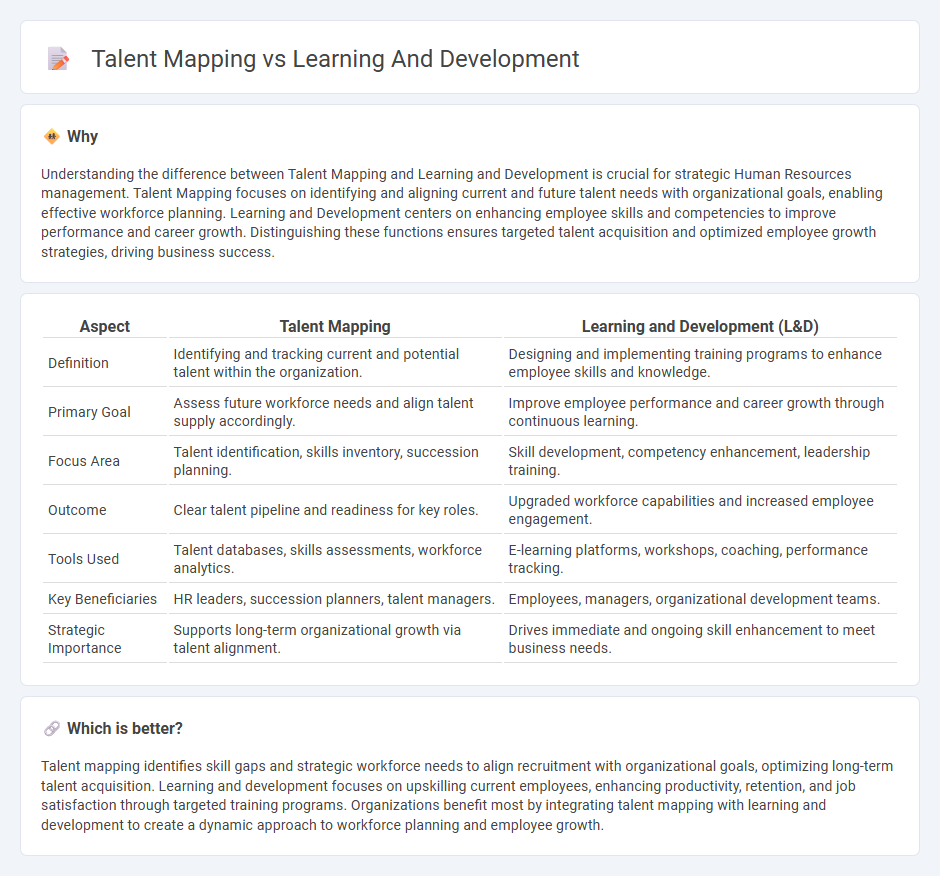
Talent mapping identifies current and future skill gaps within an organization to strategically align workforce capabilities with business goals. Learning and development focuses on upskilling employees through targeted training programs to enhance performance and career growth. Discover how combining talent mapping with learning and development optimizes employee potential and organizational success.
Why it is important
Understanding the difference between Talent Mapping and Learning and Development is crucial for strategic Human Resources management. Talent Mapping focuses on identifying and aligning current and future talent needs with organizational goals, enabling effective workforce planning. Learning and Development centers on enhancing employee skills and competencies to improve performance and career growth. Distinguishing these functions ensures targeted talent acquisition and optimized employee growth strategies, driving business success.
Comparison Table
| Aspect | Talent Mapping | Learning and Development (L&D) |
|---|---|---|
| Definition | Identifying and tracking current and potential talent within the organization. | Designing and implementing training programs to enhance employee skills and knowledge. |
| Primary Goal | Assess future workforce needs and align talent supply accordingly. | Improve employee performance and career growth through continuous learning. |
| Focus Area | Talent identification, skills inventory, succession planning. | Skill development, competency enhancement, leadership training. |
| Outcome | Clear talent pipeline and readiness for key roles. | Upgraded workforce capabilities and increased employee engagement. |
| Tools Used | Talent databases, skills assessments, workforce analytics. | E-learning platforms, workshops, coaching, performance tracking. |
| Key Beneficiaries | HR leaders, succession planners, talent managers. | Employees, managers, organizational development teams. |
| Strategic Importance | Supports long-term organizational growth via talent alignment. | Drives immediate and ongoing skill enhancement to meet business needs. |
Which is better?
Talent mapping identifies skill gaps and strategic workforce needs to align recruitment with organizational goals, optimizing long-term talent acquisition. Learning and development focuses on upskilling current employees, enhancing productivity, retention, and job satisfaction through targeted training programs. Organizations benefit most by integrating talent mapping with learning and development to create a dynamic approach to workforce planning and employee growth.
Connection
Talent mapping provides a strategic overview of current and future skills within an organization, enabling targeted Learning and Development (L&D) initiatives that address identified skill gaps. Effective L&D programs are designed based on insights from talent mapping to enhance employee competencies and align workforce capabilities with business goals. This synergy ensures a continuous talent pipeline and supports organizational growth by fostering relevant and timely skill enhancement.
Key Terms
**Learning and Development:**
Learning and Development (L&D) focuses on enhancing employee skills, knowledge, and competencies to improve performance and drive organizational growth. It involves targeted training programs, professional development workshops, and continuous learning initiatives tailored to meet business objectives. Discover how effective L&D strategies can transform workforce capabilities and support long-term success.
Training Programs
Learning and development focuses on designing and delivering training programs that enhance employee skills and organizational performance. Talent mapping involves identifying and assessing existing and potential talent to align with strategic goals, ensuring the right individuals are targeted for specific training initiatives. Explore the differences and benefits of both approaches to optimize your workforce development strategy.
Skill Assessment
Learning and development centers on enhancing employees' skills through targeted training programs, while talent mapping identifies current and future skill requirements within an organization. Skill assessment plays a pivotal role in both by evaluating proficiency levels to align workforce capabilities with strategic goals. Explore how integrating skill assessments can optimize talent development and mapping processes for improved organizational performance.
Source and External Links
Learning and Development: A Comprehensive Guide - This guide provides an overview of learning and development (L&D) as a systematic process to enhance employees' skills and knowledge, essential for better work performance and talent retention.
Learning Development - This term refers to work focused on developing academic practices in higher education, particularly aimed at students but also involving staff development and educational resources.
What is Learning and Development? - This resource describes L&D as a core HR function responsible for empowering employee growth by developing their knowledge, skills, and capabilities to drive business performance.
 dowidth.com
dowidth.com